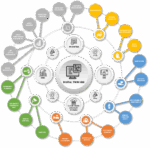
What are the Benefits of BIM Services to Key Project Stakeholders?
Building information modeling (BIM) services have revolutionized the architecture, engineering, and construction (AEC) industry, offering significant advantages to key project stakeholders. Whether you are an owner, architect, contractor, or facilities manager, BIM helps streamline processes, reduce costs, and enhance overall project outcomes.
Let’s explore how BIM services, particularly those provided by experienced consulting teams, can yield real dividends for project stakeholders.
What is Building Information Modeling?
BIM services have transformed the construction industry by providing a digital representation of a building’s physical and functional characteristics. BIM integrates detailed building data and design elements, enabling stakeholders — architects, engineers, and contractors — to collaborate more effectively throughout the project lifecycle. Initially used for pre-construction planning, BIM continues to provide strong value during and after construction as it facilitates a precise, adaptable model that reflects real-world conditions.
The primary use of BIM is to enhance design accuracy and functionality. It goes beyond simple 2D-based construction drawings by incorporating systems like plumbing, electrical, HVAC, and fire protection. BIM enables comprehensive coordination of these systems to ensure safety, compatibility, and efficiency. This functionality helps avoid construction errors, reduce material waste, and ensure projects are completed on time and within budget.
BIM services include 3D modeling, clash detection, material take-offs, and 4D scheduling. These models streamline project execution by identifying potential issues early and optimizing processes to prevent delays. By including additional dimensions such as time (4D) and cost (5D), BIM helps stakeholders better manage construction schedules and budgets.
In-House Expertise vs. External BIM Consulting: Which is Better?
It’s important for every organization to find the right BIM professional to support their efforts. Most projects consider two options: in-house BIM specialists and experienced external BIM consultants.
In-house expertise allows a company to develop dedicated BIM capabilities internally, which can be cost-effective in the long run for organizations that consistently manage large projects. However, the challenge with in-house teams lies in the cost of training and retaining BIM specialists. Additionally, as BIM technologies evolve, keeping the team updated with the latest advancements requires continuous investment in training and development.
External BIM consulting, on the other hand, provides access to highly specialized expertise that can be leveraged on an as-needed basis. Consulting firms are often at the forefront of BIM innovation and can bring fresh perspectives and the latest industry knowledge to a project. External consultants have extensive experience across various projects and sectors, which allows them to offer a broader range of solutions and best practices. They are also scalable, meaning that resources can be adjusted based on the project’s size and complexity, avoiding the overhead costs associated with maintaining a full-time in-house team.
Exploring the Benefits of BIM for Project Stakeholders
While in-house BIM teams are valuable, engaging an external BIM consultant can provide significant advantages that complement internal efforts. BIM consultants typically bring decades of combined experience across diverse project fields, offering specialized expertise tailored to your project or system without requiring significant investment in ongoing training and retention.
Here are some key benefits of hiring a BIM consultant for your next project.
1. Work with the Industry’s Best BIM Experts
One of the key advantages of hiring a BIM consultant is access to experts with specialized knowledge of your project’s unique needs. For example, if you’re constructing a healthcare facility, you can collaborate with consultants experienced in healthcare. If it’s a data center, you can rely on consultants who understand the specific complexities of such projects.
BIM consultants often focus on particular industries, bringing field-specific expertise and best practices to the table. Whether you’re involved in retail, education, hospitality, or another sector, these consultants provide insights into industry best practices that are difficult to find elsewhere. They help your organization anticipate system clashes, optimize resource allocation, and centralize knowledge management within a single BIM platform.
2. Tap Into the Industry’s Best Tech Stack
A key factor that distinguishes top BIM consultants is their investment in cutting-edge technology. They combine industry-standard software with custom-developed tools to achieve optimal results, avoiding rework, safety issues, and sustainability concerns.
BIM consultants often have access to more advanced and comprehensive tools than most in-house teams can afford to invest in. These technologies enable them to streamline communication, automate repetitive tasks like labeling, and foster greater collaboration among project stakeholders, breaking down silos that can otherwise hinder project success.
3. Scale Your Resources to Meet Demand
Hiring a BIM consultant gives your organization the flexibility to scale resources as needed, allowing you to adjust based on project timelines, budget, resource availability, and unexpected changes.
Construction projects often have fluctuating demands for BIM expertise, with certain phases like design development or construction documentation requiring more intensive involvement. Other stages may need less support. A BIM consultant offers the flexibility to scale your team up or down based on these needs, ensuring you have the right level of expertise without incurring unnecessary costs or overhead.
Managing resources with a limited in-house team, on the other hand, can be challenging, as overburdening staff may lead to burnout and reduced productivity, while underutilizing them can waste potential. A BIM consultant provides a scalable solution, ensuring that resources are allocated efficiently throughout the project.
4. Keep Overhead Costs Low
Unlike traditional employees who remain on payroll regardless of workload, BIM consultants operate on a pay-as-you-go basis. You only incur costs when they are actively working on your project, eliminating the need for a full-time salary commitment.
Maintaining an internal BIM team can become costly, especially during periods of low activity or when specific expertise isn’t needed. Salaries, benefits, and other associated expenses continue to accumulate even without direct project contributions. By engaging BIM consultants only when required, you can reduce these idle resource costs and optimize your budget.
Consult the World’s Leading BIM Experts
VIATechnik is a trusted leader in BIM services, partnering with top clients across a wide range of industries, including aviation and healthcare. Our tailored BIM solutions are designed to save your team time, effort, and costs by detailing every critical aspect of your project and centralizing data for seamless sharing.
Connect with VIATechnik today to discover how our building information modeling services can elevate your next construction project.



